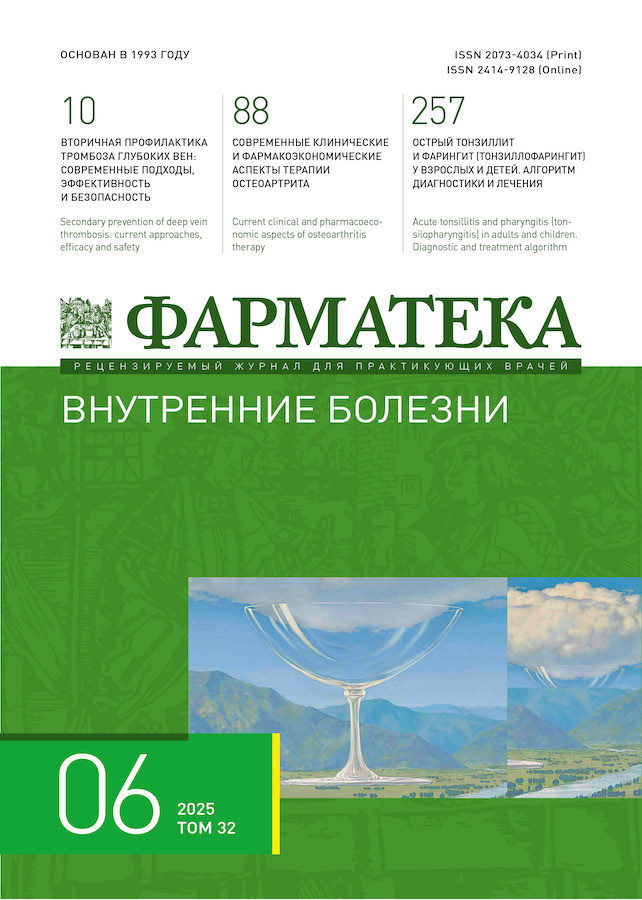Clinical efficacy of combination antiviral therapy in patients with Herpes zoster
- Autores: Pritulina Y.G.1, Gankovskaya L.V.2, Babenkova D.V.1
-
Afiliações:
- Voronezh State Medical University named after N.N. Burdenko
- Pirogov Russian National Research Medical University
- Edição: Volume 32, Nº 6 (2025)
- Páginas: 70-77
- Seção: Pulmonology/ENT/ARVI
- URL: https://journals.eco-vector.com/2073-4034/article/view/695590
- DOI: https://doi.org/10.18565/pharmateca.2025.6.70-77
- ID: 695590
Citar
Texto integral
Resumo
Background: Varicella Zoster Virus (VZV) is a type III herpesvirus infection. Viral reactivation leading to the development of herpes zoster (HZ) is more common in older individuals, especially those with comorbidities, with the potential for severe disease progression and complications such as bacterial superinfection and postherpetic neuralgia. Suppression of innate and adaptive immunity plays a key role in controlling viral latency and reactivation. Standard treatment for herpes zoster includes etiotropic therapy with the antiviral drug acyclovir. However, given the frequency of herpes zoster recurrences and its immunosuppressive effects, immunomodulatory agents are necessary.
Objective: Evaluation of the effectiveness of herpes zoster therapy with the inclusion of the immunostimulant Superlymph® in the traditional treatment regimen.
Materials and methods: Peripheral blood samples were analyzed from 40 patients with recurrent herpes zoster, divided into two comparable treatment groups (receiving only the traditional acyclovir regimen or combination therapy with the addition of the immunostimulant Superlymph) and 10 healthy control subjects matched for age and gender. Soluble toll-like receptor (sTLR) levels were determined in serum using ELISA. In addition, T-cell subset characteristics were determined using flow cytometry, and the cytokine profile was analyzed using ELISA.
Results: The study identified a range of key cytokine profile parameters, determined cellular (T-lymphocyte subsets) and innate (sTLR) immunity in patients with herpes zoster, and developed a differentiated approach to selecting immunocorrective therapy as part of the combination treatment of herpes zoster during the acute phase.
Conclusion: Dysfunction of various T-lymphocyte subsets, cytokine profile imbalance, and sTLR activation are important mechanisms for the development of herpes zoster relapses. These laboratory parameters substantiate the effectiveness of using an immunobiological suppository containing a complex of natural antimicrobial peptides and cytokines in combination therapy in at-risk patients.
Palavras-chave
Texto integral
Sobre autores
Yu. Pritulina
Voronezh State Medical University named after N.N. Burdenko
Email: pritulina1@gmail.com
Código SPIN: 6102-2934
Dr. Sci. (Med.), Professor, Department of Infectious Diseases
Rússia, VoronezhL. Gankovskaya
Pirogov Russian National Research Medical University
Autor responsável pela correspondência
Email: lvgan@yandex.ru
ORCID ID: 0000-0003-1271-3078
Dr. Sci. (Med.), Professor, Professor at the Department of Immunology, MBF
Rússia, MoscowD. Babenkova
Voronezh State Medical University named after N.N. Burdenko
Email: konsti12@mail.ru
Código SPIN: 5054-2996
Teaching Assistant, Department of Infectious Diseases
Rússia, VoronezhBibliografia
- Клинические рекомендации «Опоясывающий лишай». Общероссийская общественная организация «Российское общество дерматовенерологов и косметологов», 2020. [Clinical guidelines «Shingles». All-Russian public organization «Russian Society of Dermatovenerologists and Cosmetologists», 2020. (In Russ.)].
- Железникова Г. Ф. и др. Вирус ветряной оспы – опоясывающего герпеса иммунный ответ. Российский иммунологический журнал. 2013;7(16):35–48. [Zheleznikova G.F. et al. The varicella-zoster virus immune response. Russian Journal of Immunology. 2013;7(16):35–48. (In Russ.)].
- Patil A., Goldust M., Wollina U. Herpes zoster: A Review of Clinical Manifestations and Management. Viruses. 2022;14(2):192. https://dx.doi.org/10.3390/v14020192
- Игонина И.А., Колоколов О.В., Бакулев А.Л., и др. Комплексное лечение герпетических поражений периферической нервной системы. Русский медицинский журнал. 2013;30:1518. [Igonina I.A., Kolokolov O.V., Bakulev A.L., et al. Complex treatment of herpetic lesions of the peripheral nervous system. Russian Medical Journal. 2013;30:1518. (In Russ.)].
- Бабенкова Д.В., Притулина Ю.Г. Способ лечения опоясывающего герпеса. Патент на изобретение RU 2796387 C1, 22.05.2023. Заявка № 2023105789 от 13.03.2023. [Babenkova D.V., Pritulina Yu.G. Method for treating herpes zoster. Patent for invention RU 2796387 C1, 22.05.2023. Application No. 2023105789 dated 03/13/2023. (In Russ.)].
- Chen W., Zhu L., Shen L.L., et al. T Lymphocyte subsets profile and Toll-like receptors responses in patients with herpes zoster. J Pain Res. 2023;16:1581–1594. https://dx.doi.org/10.2147/JPR.S405157
- Xing Q., Hu D., Shi F., Chen F. Role of regulatory T cells in patients with acute herpes zoster and relationship to postherpetic neuralgia. Arch Dermatol Res. 2013;305(8):715–22. https://dx.doi.org/10.1007/s00403-013-1367-0
- Ku C.C., Chang Y.H., Chien Y., Lee T.L. Type I interferon inhibits varicella-zoster virus replication by interfering with the dynamic interaction between mediator and IE62 within replication compartments. Cell Biosci. 2016;6:21. https://dx.doi.org/10.1186/s13578-016-0086-6
- Nikkels A.F., Sadzot-Delvaux C., Piérard G.E. Absence of intercellular adhesion molecule 1 expression in varicella zoster virus-infected keratinocytes during herpes zoster: another immune evasion strategy? Am J Dermatopathol. 2004;26(1):27–32. https://dx.doi.org/10.1097/00000372-200402000-00005
- Wang J.P., Kurt-Jones E.A., Shin O.S., et al. Varicella-zoster virus activates inflammatory cytokines in human monocytes and macrophages via Toll-like receptor 2. J Virol. 2005;79(20):12658–12666. https://dx.doi.org/10.1128/JVI.79.20.12658-12666.2005
Arquivos suplementares








